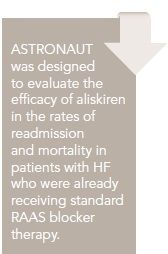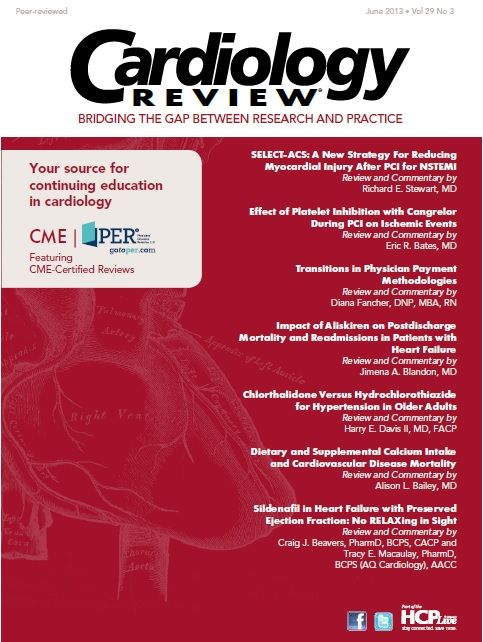Publication
Article
Cardiology Review® Online
Impact of Aliskiren on Postdischarge Mortality and Readmissions in Patients with Heart Failure

Jimena A. Blandon, MD
Review
Gheorghiade M, Bohm M, Greene SJ, et al. Effect of aliskiren on postdischarge mortality and heart failure readmissions among patients hospitalized for heart failure: the ASTRONAUT randomized trial. JAMA. 2013;309:1125-1135.

Heart failure (HF) is a common, costly, disabling, and potentially deadly condition. In developed countries, approximately 2% of adults suffer from HF, and this percentage increases to 10% in patients older than 65 years.1 In the United States, 5.7 million people suffer from HF, and each year nearly 500,000 new cases are diagnosed, causing more than 55,000 deaths anually.2 HF may not be reversible, and typically cardiac function deteriorates with time, causing about half of these patients to die within 5 years of diagnosis.3 Progressive HF is associated with an overall annual mortality rate of 10%. Of even greater concern is that despite treatment with existing medications, more than half of HF patients 65 years or older seek readmission within 6 months of treatment, with an average duration of hospital stay of 6 days.4 HF admissions and readmissions cost the nation $34.4 billion annually if all the care services, medications, and lost productivity are calculated; a big percentage of Medicare reimbursements are due to HF readmissions.
Thus it is critical that time and resources be dedicated to investigate treatments that will help avoid HF readmissions.
Previous studies have shown that blockage of the renin-angiotensin-aldosterone system (RAAS) plays an essential role in the expression of cardiovascular diseases. Renin cleaves angiotensinogen, converting it to angiotensin (AT) 1, which is converted by angiotensin-converting enzyme (ACE) to angiotensin 2, which in turn binds to AT receptors in the zona glomerulosa of the adrenal gland, promoting the synthesis of aldosterone. The blockage in angiotensin 2 also represents a loss in the negative feedback to suppress further release of renin. When RAAS agents are used chronically, the body increases renin production — another reason to find medications that inhibit renin directly.5
The finding that renin is highly selective — its only naturally occurring substrate is an angiotensinogen binding site — led to interest in the development of a medication that would act selectively, inhibiting this enzyme with a lower incidence of unwanted side effects.
Renin is crucial in the activation of the RAAS. The direct renin inhibitor (DRI) aliskiren blocks this rate-determining step in the RAAS cascade. Aliskiren has been a new promising option for the treatment of HF, and it is the first drug of this class, approved in 2007 for the treatment of hypertension.6
In the AVOID study, aliskiren was recognized for its reno-protective effects, lowering the proteinuria in patients with hypertension, diabetes mellitus type 2 (DM 2), and nephropathy compared with placebo.7 In addition, the ALOFT trial demonstrated that aliskiren reduced plasma levels of NT-pro BNP (N-terminal prohormone of brain natriuretic peptide) and BNP and urinary (but not plasma) aldosterone, which suggests a favorable neurohumoral effect to halt the progression of HF.8
The ASTRONAUT study was designed to evaluate the efficacy of aliskiren in the rates of readmission and mortality in patients with HF who were already receiving standard RAAS blocker therapy.
Study Details
ASTRONAUT was an international, double-blind, placebo-controlled study that randomized 1639 men and women 18 years and older who were hospitalized for HF and stable enough to receive aliskiren upon discharge. The trial enrolled 1615 patients from 316 centers, divided into 2 groups: 808 received aliskiren and 807 received placebo. Both groups had similar characteristics at admission and randomization: a low ejection fraction (LVEF ≤40%), elevated BNP (>400 pg/mL) or NT-pro BNP (>1600 pg/mL), and signs or symptoms of fluid overload.
These 2 groups were similar with regard to DM2 status (41% of patients), renal function (mean glomerular filtration rate [GFR], 67 mL/min/1.73 m2), hypertension, coronary artery disease, and atrial fibrillation. It is interesting to note that patients were first stabilized, so the median NT-pro BNP was 4239 pg/mL on admission and lowered to 2718 pg/mL at randomization.
Applied criteria for exclusion were documented events 3 months prior to enrollment, including: myocardial infarction (MI), cardiac surgery, or stroke, the use of a ventricular assist device, the presence of any mechanical support, history of cardiac transplant or awaiting transplant, significant hemodynamic instability due to uncorrected primary cardiac valvular disease, right heart failure due to pulmonary disease, important renal impairment (eGFR ≤40 mL/min/1.73 m2), hyperkalemia >5 mEq/L, and comorbid conditions that signified expected survival less than 3 years.
The treatments and stages of HF were similar in the 2 groups, as were their initial evidence-based HF therapies on discharge. The patients were randomized to receive either aliskiren, starting at 150 mg and increasing to 300 mg if tolerated, or placebo. The patients were followed every 2 weeks for 3 months and then every 3 months for 1 year.
The primary end point was defined as the occurrence of a cardiovascular event (CV) or readmission measured 6 months after randomization. The same parameters were measured at 12 months, constituting the secondary end point. Other secondary end points were first CV event (CV death, HF hospitalization, nonfatal MI, nonfatal stroke, and resuscitated sudden death) within 12 months; all-cause mortality at 6 and 12 months; changes from baseline NT-pro BNP level (at 1, 6, and 12 months); and quality of life, activities of daily living assessed by the Kansas City Cardiomyopathy Questionnaire. The primary end point was reached by 201 (24.9%) patients in the aliskiren group and 214 (26.5%) patients in the placebo group (hazard ratio [HR], 0.92; 95% confidence interval [CI], 0.76-1.12, P = 0.41). These events, CV death, and HF rehospitalization were equally represented in the 2 groups (HR, 0.92 and 0.90, respectively).
The secondary end points did not differ between treatment groups for CV events or readmissions for HF at 12 months. The first CV events did not reach statistical significance, but the events were numerically lower in the aliskiren group for the combined composite and individual components: specifically, nonfatal MI was lower in the aliskiren group (P = 0.009).
During the entire follow-up period (0.1-31.2 months), the total hospitalization for any reason was similar in the aliskiren and the placebo groups (48.1% vs 49.1%) and the HF hospitalizations at 12 months were 26.2% in the aliskiren group versus 27.8% in the placebo one.
Notably, patients in the aliskiren group showed a sustained drop of blood levels of NT-pro BNP, a hormone that serves as a marker for progression of HF. Unfortunately, this did not correlate with the clinical manifestations of HF; in fact, the rate of complications was in the opposite direction: in the aliskiren versus the placebo group, the rates of hyperkalemia (169 vs 142, relative risk [RR],1.19 (CI, 0.98-1.46) P = 0.09], hypotension (138 vs 103; RR, 1.36 (CI, 1.07-1.72) P = 0.01], and renal impairment (134 vs 98; RR, 1.36 [CI, 1.08-1.75] P = 0.01) were higher.
CommentaryFalling Short of Expectations
Treatment of HF with RAAS blockers was expected to decrease mortality and readmissions in patients discharged with congestive heart failure.1 These patients fail to show stabilization of HF complications and experience no change in the likelihood of readmission with conventional gold-standard therapies and continue to have a high rate of mortality in spite of novel therapies. The negative effects associated with aliskiren are overcoming the benefits on the progression of HF suggested by longterm improvement in levels of natriuretic peptide.
Direct renin inhibitors like aliskiren constitute a promising option due to previous benefits in decreasing BNP and renoprotection, but the ASTRONAUT study failed to demonstrate this advantage. Even worse, in this study there was an increase in the adverse effects in the aliskiren subgroup, especially with respect to renal failure, hypotension, and other symptoms that were not necessarily significant enough for the patients to be withdrawn from the study.
Earlier studies showed that aliskiren, when used with other RAAS blockers, was linked to an increased risk of developing hyperkalemia, hypertension, and renal failure, especially in the DM2 patients.9
It is noteworthy that the patients in the aliskiren arm of the study had a statistically significant decrease in the relative risk for developing non-fatal acute MI.
The fact that the nondiabetic population did better in this study suggests that future research should investigate whether the beneficial effects of aliskiren are seen in patients who are not diabetic. It is believed that due to the complex renal physiologic disarrangements seen in DM2, the use of aliskiren associated with other RAAS agents should be tested in a nondiabetic population to gain a better understanding of the exact benefits that might be added to the armamentarium of drugs to treat HF patients.
Previous studies using associations of RAAS inhibitors demonstrated an increment in the adverse effects that limit its combined use and require strict follow up,10-12 especially for the occurrence of hyperkalemia, hypotension, and renal impairment. It would be interesting to know if the combination of aliskiren with either an angiotensin-converting enzyme inhibitor (ACEI) or angiotensin receptor blocker (ARB) or with an aldosterone inhibitor (dual therapy) would be better than “triple therapy” combining aliskiren plus ACEI/ARB plus an aldosterone inhibitor with respect to the incidence of hyperkalemia. Future studies are needed to provide more data on aliskiren’s effects in patients with and without HF and DM2.
References
1. Roger VL, Go AS, Lloyd-Jones DM, et al. Heart disease and stroke statistics—2012 update: a report from the American Heart Association. Circulation. 2012;125:e2-e220.
2. Kochanek KD, Xu JQ, Murphy SL, Miniño AM, Kung HC. Deaths: final data for 2009. National Vital Statistics Reports. 2011;60(3).
3.Heidenriech PA, Trogdon JG, Khavjou OA, et al. Forecasting the future of cardiovascular disease in the United States: a policy statement from the American Heart Association. Circulation. 2011;123:933-944.
4.Wang G, Zhang Z, Ayala C, Wall HK, Fang J. Costs of heart failurerelated hospitalizations in patients aged 18-64 years. Am J Manag Care. 2010;16:769-776.
5. Jensen C, Herold P Brunner HR. Aliskiren: The first renin inhibitor for clinical treatment. Nature Rev Drug Disc. 2008;7:399-410.
6. Seed A, Gardner R, McMurray J, et al. Neurohumoral effects of the new orally active renin inhibitor, aliskiren, in chronic heart failure. Eur J Heart Fail. 2007;9:1120e7.
7. Parving HH, Persson F, Lewis JB, Lewis EJ, Hollenberg NK. Aliskiren combined with losartan in type 2 diabetes and nephropathy. N Engl J Med. 2008;358:2433-2446.
8. McMurray JJ, Pitt B, Latini R, et al; Aliskiren Observation of Heart Failure Treatment (ALOFT) Investigators. Effects of the oral direct renin inhibitor aliskiren in patients with symptomatic heart failure. Circ Heart Fail. 2008;1:17-24.
9. Parving HH, Brenner BM, McMurray JJ, et al. Aliskiren Trial in Type 2 Diabetes Using Cardio-Renal Endpoints (ALTITUDE): rationale and study design. Nephrol Dial Transplant. 2009;24:1663.
10. Parving HH, Persson F, Lewis JB, et al. Aliskiren combined with losartan in type 2 diabetes and nephropathy. N Engl J Med. 2008;358:2433.
11. Harel Z, Gilbert C, Wald R, et al. The effect of combination treatment with aliskiren and blockers of the renin-angiotensin system on hyperkalaemia and acute kidney injury: systematic review and meta-analysis. Br Med J. 2012;344:e42.
12. Granger CB, McMurray JJ, Yusuf S, et al. Effects of candesartan in patients with chronic heart failure and reduced left-ventricular systolic function intolerant to angiotensin-converting-enzyme inhibitors: the CHARMAlternative trial. Lancet. 2003;362:772.
About the Author
Jimena A. Blandon, MD, is a third-year resident instructor in the Department of Internal Medicine at Texas Tech University Health Sciences Center in El Paso. She received her MD at Universidad del Valle, in Cali, Colombia. Dr. Blandon will be continuing her training in a nephrology fellowship at Cleveland Clinic Florida.





